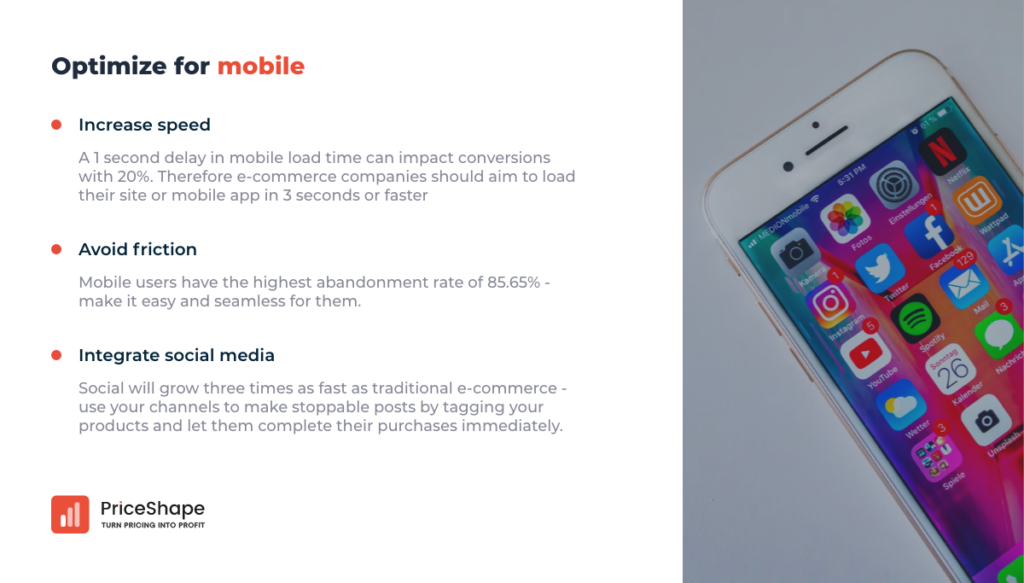How To Provide Superior E-Commerce Experiences With Data
A lot goes into developing and maintaining a comprehensive and healthy e-commerce business. Learn how to by reading this blog post
A lot goes into developing and maintaining a comprehensive and healthy e-commerce business. You might offer various quality products, create phenomenal copy, and excel in email marketing, social media strategy, and paid advertising.
But the level of success of your hard work all boils down to how the customer reacts to it. And this depends on how well you know your customers.
And while we’re going down this rabbit hole, let me ask you this. How often do you remember to check your customer data before taking action on a new idea? Or coming up with one in the first place?
Using customer data has become a deal breaker for your business. It can help tweak everything about your business to better fit your customers needs. Both better personalized communication and improve the experience of your e-commerce business, and so much more. Making it well worth the effort. According to HubSpot 80% of consumers are more likely to make a purchase, when brands offer personalized experiences.
And don’t worry. In this blog post we’ll show you how you can take the experience of your e-commerce from super to superior.
Personalize your ads
Personalizing the e-commerce customer experience is, by today’s standards, essential to your success. There is no other way to put it. Even Gen X and Millennial consumers say they’ll happily share their personal data in exchange for personalized offers.
Personalization in e-commerce means delivering tailored content and promotions to customers based on their actions, throughout their customer journey. You can use insights such as their demographics, interests, life events, buying intent, and/or behavioral patterns.
You can also practice message matching. PPC ads account for 64.6% of clicks when people search online. Message matching your ads to your post-click landing page reinforces both relevancy and the overall message in their minds. This has the potential to make them more prone to buy.
This might sound really simple and like a no brainer, but message matching is especially important with retargeting campaigns. Fact is that 96% of users leave a website without converting. And to put it into perspective, it can take up to 4 revisits before they will make a purchase.
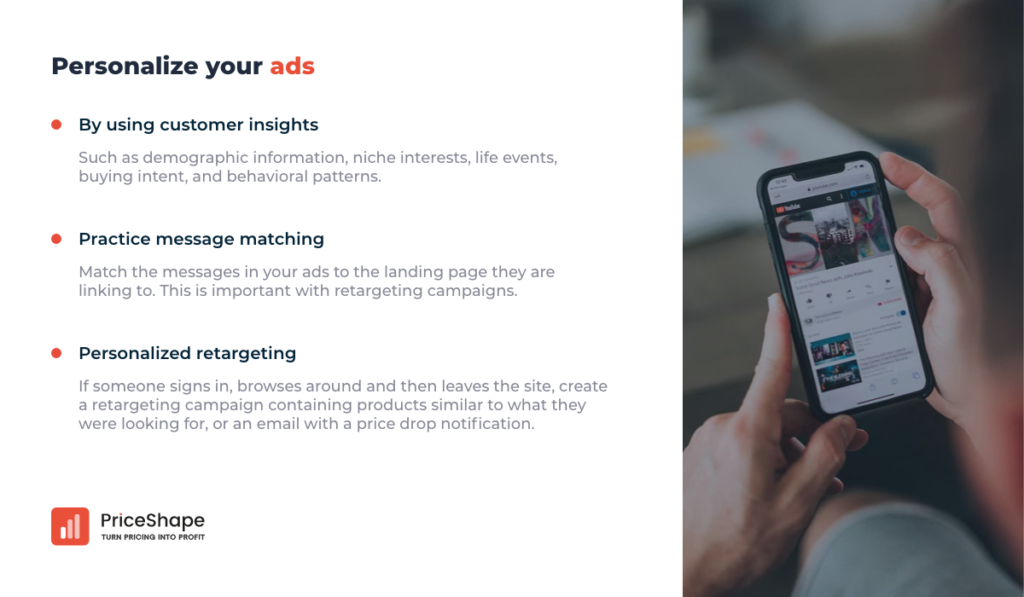
Luckily, e-commerce marketers can take advantage of personalized retargeting, similar to PPC marketers. This means that if someone signs in, browses around and then leaves the site, you can hit them with a retargeting campaign. This campaign/ad can contain products similar to what they were looking at, or an email with a discount code/price drop. But we will cover this bit a little later.
Make your website user-friendly
There is a rule of thumb in e-commerce, which says that online shoppers tend to fall into three categories, 1) those that know what they want, 2) those that are browsing and 3) those that need help filtering through your products.
The common ground for them all is that they want easy-to-navigate pages. Pages that allow them to browse products and find exactly what they need. To meet this demand in best way possible, your website should be organized by categories, just like a physical store. Luckily, there are a few easy tactics you can take to, such as;
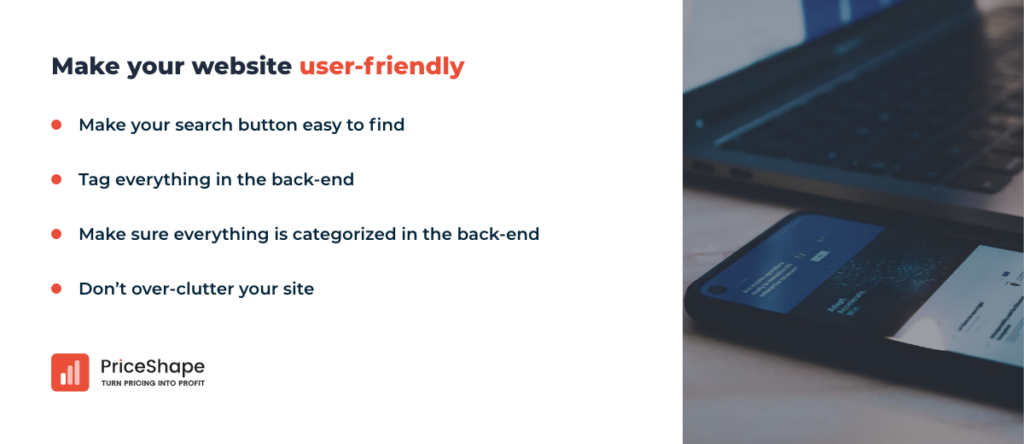
A good example of using these tactics is the clothing brand Zara. They list all their product categories as a “static carousel” which highlights as you scroll down the front page. Additionally, the search bar is clearly visible at the top of the page. It’s simple and doesn’t offer the consumer too many distractions, so getting what they came for is easy.
Amazon does a great job of UX/website personalization as well. When you go to their homepage, they give you personalized recommendations based on your recent purchases and shopping trends.
Another side to this coin is website personalization. This will also enhance the user experience by addressing customers’ needs and desires before they mention them. In fact 91% of consumers prefer to shop with brands that give them personalized recommendations according to Hubspot. This can improve both traffic, customer retention, and sales.
Personalizing a website means tailored recommendations and offers, and implementing dynamic content based on customer data. In order to create an personalized web experience for each customer, use the data you've permission to collect. This could be behavior, their demographics, past purchases, their interests, time spent on page, device type, geolocation or buyer personas.
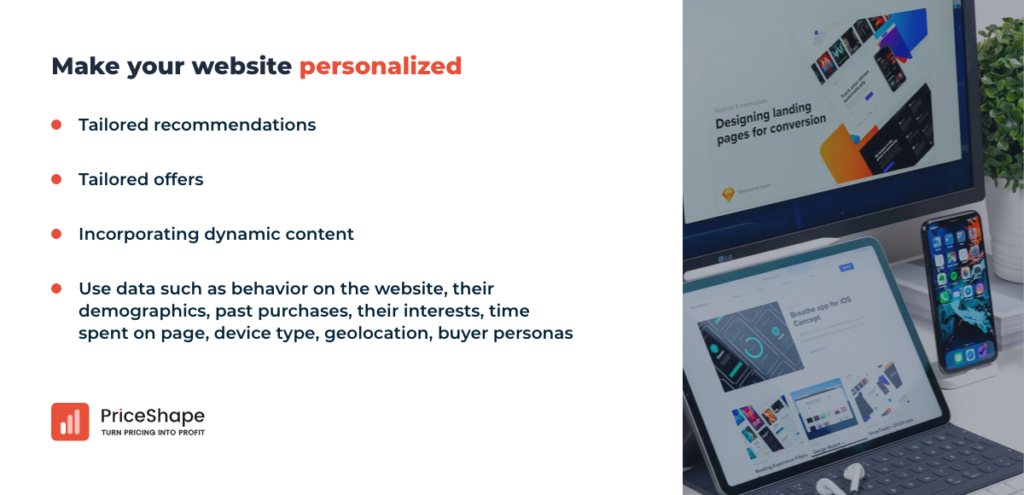
Price optimization
Did you know that 53% of people around the world shop online because of free delivery? Or that the biggest reason for people abandoning their cart is due to extra cost such as shipping?
An obvious solution to this could be retailers and brands covering extra costs like shipping themselves by increasing their prices. But an increase in price is not something that should be done without insights into your competitive landscape. A an price increase will instantly affect your position in the market, customer experience and sales.
But we can’t avoid the fact that free delivery is incredibly important for consumers when they are shopping online. And even more so on Google Shopping. Thus it should be one of the first things you look into if to offer the best customer experience.
To do this you could consider whether or not your delivery costs should added to the price of your products. But as mentioned, it is important that you are making this decision based on competitor insights. This means how much your competitors are charging for both the same product and their delivery.
This will help you create better pricing strategies and gain revenue that will allow you to offer free delivery, f.x on Google Shopping. Fact is that 68% of online shoppers search a product on Google before purchasing. This makes Google Shopping an important part of your e-commerce strategy and the experience of your e-commerce.
Google Shopping presents both the delivery costs as well as the product costs for each product on their platform. Additionally, they also allow consumers to filter products by ‘free delivery’. This means, even if you have the cheapest product price, you may not win the sale due to shipping costs. This alone emphasizes the importance of having access to proper market data, and your competitors product and delivery prices.
At PriceShape we monitor your competitors’ prices and your competitors’ delivery charges. This means you’re able to take this information into account when creating your price strategies and practice dynamic pricing. This will help you create the best customer experience, maximize revenue and win more sales. You can also let our software intelligence do it for you.
Practicing dynamic pricing creates great results for various businesses. We have seen results of
- +200% increase in revenue, due to increased sales based on more competitive prices
- 96% growth in ROAS
- 6x increase in their monthly revenue
All results are effects of being priced correctly, and/or using custom labels created from PriceShape in their Google Shopping.
But it is important to remember that winning more sales is not about being the cheapest one on the market. It’s about being competitive by offering the best experience to your customers - and this includes the best price. You might be able to increase your prices and still be the most competitive without even knowing it. All you need is actual and real competitor- and market insights - and this is exactly what PriceShape is all about.
Make purchasing seamless
Bettering the experience of your e-commerce touches upon a lot of different things surrounding your business - including the checkout process. Creating a more seamless buying experience for the customer has the potential to reduce the number of abandoned carts.
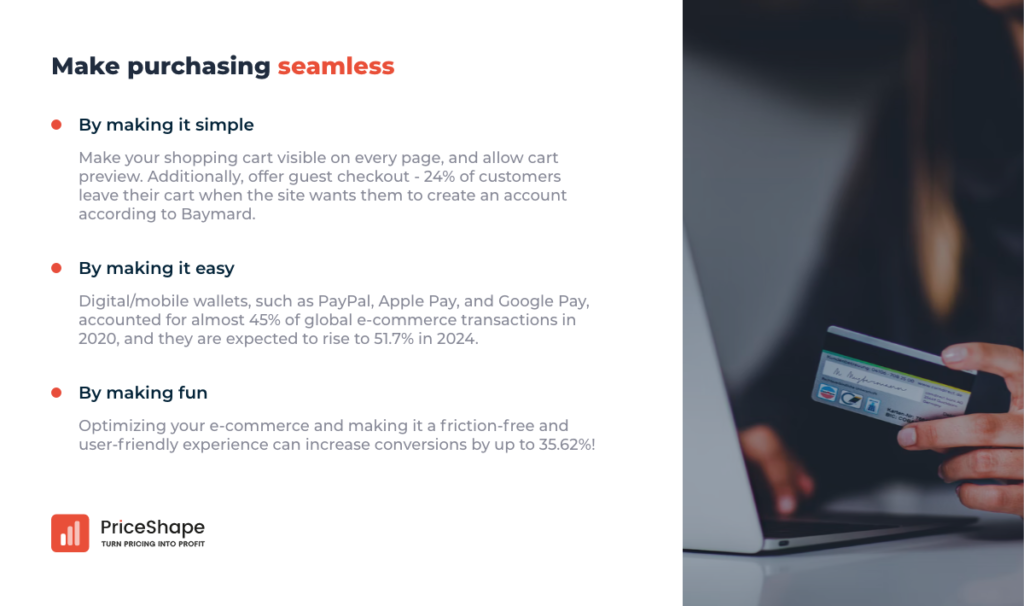
Surprise your customers!
Online shoppers like surprises! Well, as long as they are good surprises and to their benefit. But a little surprise goes a long way, and can really enhance the experience of your e-commerce.
One of the surprises you can offer your customers is free shipping. 53% of people around the world shop online because of free delivery. Consequently, making extra costs are the biggest reason for cart abandonment.
Another surprise you can give your customers is providing a discount coupon/code with their parcels. Additionally, once a consumer makes a purchase, you can personalize their confirmation e-mail with related products.
Amazon is a great example of this. They have incorporated a “Trending near you” (geographic personalization) section at the bottom of their mails. This recognizes the shipping address/postal code, and offers products that've been trending in that area. They especially practice this during periods with heavy wildfire smoke the San Francisco Bay Area. When someone from that area shops with Amazon during a wildfire, they recognize the shipping address, and offer air purifiers and respiratory masks in their emails.
Maybe geographic personalization is not suitable for your specific business or product, but you can use a similar tactics by offering ‘related products’, ‘others who bought this looked at’ or ‘seasonal favorites’.
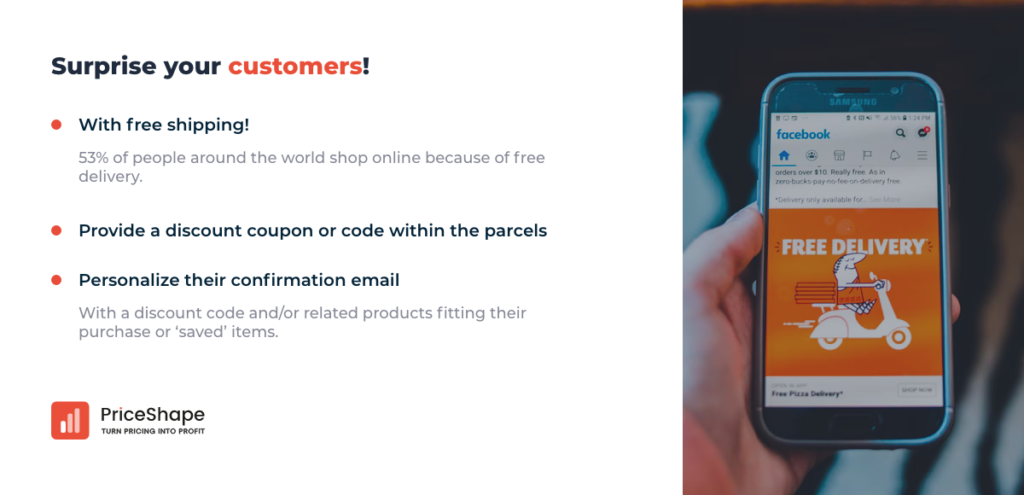
Improve your email marketing
To a large extent offering the best e-commerce experience for your customers means personalization. And as we’ve covered in this blogpost, it goes beyond incorporating your customer’s name in emails. Personalization, when done right, provides your customers with an exceptional experience of your e-commerce. And it will help drive impulse purchases, decrease number of returns, and increase loyalty.
Thus content, product offers, ads, and even emails should be relevant to a user or they will get annoyed with your business. But thankfully there are tactics you can use that will help provide a better experience through emails:
- Before a purchase
If someone signs up/creates an account - send them a welcome email with a personal discount code. If they save a few items but don't purchase - remind them when the items are on sale or lure them back in with, f.x. free shipping. You can also hit them with a retargeting campaign containing products similar to what they were saving or looking for. - After a purchase
Follow up with the customer to check everything went smoothly, offer a discount on future purchases or free shipping. Keep customers informed of special offers, the status of their saved items, and new products and services. - If a purchase didn’t happen
Send follow up ‘abandoned cart’ emails - maybe even with a ‘related products’ section in the bottom. According to a study by Moosend, abandoned cart emails have an average open rate of 45%. Additionally, a 21% click-through rate, whereas half of those clicks tracked in the study resulted in purchases. This kind of email should include a little surprise like free shipping for a limited time or a discount code. - Go above and beyond
Practicing dynamic content in your emails allows you to determine who sees what content within an email. This means you can show different content blocks to various audience segments, all within the same email campaign. It is personalization at it's finest
Optimize for mobile
Despite mobile commerce has been slowing over the past few years, there’s no indication that mobile commerce growth will stop anytime soon. Especially not with 5.22 billion mobile users and growing.
But even though the mobile commerce growth rate no longer follows the average YoY increase of 29.8% (2016 to 2021), revenue from mobile commerce multiplied by more than x 3.5 in 2021 compared to 2016. Thus mobile commerce still offers impressive results and is an important part of an e-commerce strategy. But consumers today have exceptionally high standards for a mobile experience. But don't worry - here is what you can do to cater to their needs:
- Speed matters
Google reported that 54% of people say that as the load time for a brand’s mobile site increases, so does their frustration. Even a 1-second delay in mobile load time can impact conversions with 20%. Therefore e-commerce companies should aim to load their site or mobile app in 3 seconds or faster. Fact is that shoppers who visit fast websites aren't just more likely to convert; they're more likely to browse and add additional products to their orders.
- Avoid any friction in your mobile experience
Mobile users have the highest abandonment rate of 85.65%, and research indicates that 25% of users will only open an app once. Both stats underlining the importance of delivering a good digital experience for new users isn’t optional — it’s mandatory. You can eliminate any friction for your users by;
- Decrease the number of steps a customer has to go through during checkout
- Decrease the number of form fields to fill out
- Offer guest checkout
We have gone further into these in our recent blogpost about top 6 strategies to lower cart abandonment!
- Integrate your e-commerce site with social media
Social media is undeniably an important part in running an e-commerce, but not every media is relevant to every business. Take Pinterest and Instagram. These are two social media sites that are focused on visual content. This make them highly relevant for example clothing-, interior-, beauty- and lifestyle brands.
Accenture predicts social commerce, f.x. on medias like Instagram and Pinterest will grow x3 as fast as traditional e-commerce. Thus more than doubling from $492 billion worldwide in 2021 to $1.2 trillion in 2025. It is therefore undeniably a must to integrate your e-commerce site with these channels to capture more sales from mobile app users.
Try using Pinterest’s Rich Pins or Buyable Pins to show customers the price and availability of your products. Here the shoppers can complete their purchase immediately, rather than visiting a separate web page to check out.
On Instagram, you can tag products in your feed and make them into “shoppable posts”. These posts contain tags which will lead to a product catalog and contain a direct link to your website for purchase.
